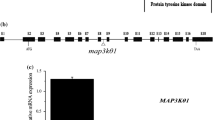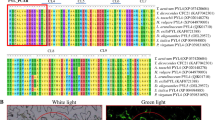Abstract
In our previous study, AtDBP1 encoding a DBP factor was identified as a putative abiotic stress candidate gene. DBP factors are important regulators that participate in both transcriptional regulation and post-translational regulation, but their roles in abiotic stress are still not well-understood. So we conducted a detailed study on the function of AtDBP1 in abiotic stress. It is found that expression of AtDBP1 could be induced by drought and salt, and the induction by salt was inhibited in ABA-deficient mutant aba2-3, indicating the expression of AtDBP1 was ABA-inducible. Overexpression of AtDBP1 resulted in a rapid stomatal closure, and elevated expression of drought/salt-responsive genes, which should help Arabidopsis to enhance the drought and salt tolerance. Unexpectedly, overexpression of AtDBP1 decreased the drought and salt tolerance of Arabidopsis. Further analysis suggested that AtDBP1 is involved in cuticle wax and cuticle membrane regulation. Overexpression of AtDBP1 showed increased cuticular conductance due to a decreased cuticle wax accumulation and cuticle membrane thickness. The cuticular wax provides an essential barrier for decreasing nonstomatal water loss during drought stress, so overexpression of AtDBP1 showed decreased drought tolerance possibly ascribed to the change of cuticle membrane structure. Our previous study elucidated that AtDBP1 was also involved in flowering time regulation. Taken together, the results above indicated that AtDBP1 was involved in both plant development and stress regulation. The mechanism of AtDBP1 in this study indicates that genes involved in both plant development and stress regulation might be not suitable for production application in breeding. Collectively, our results provide some new ideas on purposefully increasing the abiotic stress without influence on plant growth and development.




Similar content being viewed by others
References
Cohen P (1989) The structure and regulation of protein phosphatases. Annu Rev Biochem 58:453–508. https://doi.org/10.1146/annurev.bi.58.070189.002321
Schweighofer A, Hirt H, Meskiene I (2004) Plant PP2C phosphatases: emerging functions in stress signaling. Trends Plant Sci 9:236–243. https://doi.org/10.1016/j.tplants.2004.03.007
Carrasco JL, Ancillo G, Mayda E, Vera P (2003) A novel transcription factor involved in plant defense endowed with protein phosphatase activity. EMBO J 22:3376–3384. https://doi.org/10.1093/emboj/cdg323
Carrasco JL, Castello MJ, Vera P (2006) 14–3-3 mediates transcriptional regulation by modulating nucleocytoplasmic shuttling of tobacco DNA-binding protein phosphatase-1. J Biol Chem 281:22875–22881. https://doi.org/10.1074/jbc.M512611200
Castello MJ, Carrasco JL, Vera P (2010) DNA-binding protein phosphatase AtDBP1 mediates susceptibility to two potyviruses in Arabidopsis. Plant Physiol 153:1521–1525. https://doi.org/10.1104/pp.110.158923
Li Y, Zhu Y, Liu Y, Shu Y, Meng F, Lu Y, Bai X, Liu B, Guo D (2008) Genome-wide identification of osmotic stress response gene in Arabidopsis thaliana. Genomics 92:488–493. https://doi.org/10.1016/j.ygeno.2008.08.011
Zhai H, Ning W, Wu H, Zhang X, Lu S, Xia Z (2016) DNA-binding protein phosphatase AtDBP1 acts as a promoter of flowering in Arabidopsis. Planta 243:623–633. https://doi.org/10.1007/s00425-015-2433-y
Zhai H, Bai X, Zhu Y, Li Y, Cai H, Ji W, Ji Z, Liu X, Liu X, Li J (2010) A single-repeat R3-MYB transcription factor MYBC1 negatively regulates freezing tolerance in Arabidopsis. Biochem Biophys Res Commun 394:1018–1023. https://doi.org/10.1016/j.bbrc.2010.03.114
Willems E, Leyns L, Vandesompele J (2008) Standardization of real-time PCR gene expression data from independent biological replicates. Anal Biochem 379:127–129. https://doi.org/10.1016/j.ab.2008.04.036
Ning W, Zhai H, Yu J, Liang S, Yang X, Xing X, Huo J, Pang T, Yang Y, Bai X (2017) Overexpression of Glycine soja WRKY20 enhances drought tolerance and improves plant yields under drought stress in transgenic soybean. Mol Breed 37:19. https://doi.org/10.1007/s11032-016-0614-4
Saez A, Robert N, Maktabi MH, Schroeder JI, Serrano R, Rodriguez PL (2006) Enhancement of abscisic acid sensitivity and reduction of water consumption in Arabidopsis by combined inactivation of the protein phosphatases type 2C ABI1 and HAB1. Plant Physiol 141:1389–1399. https://doi.org/10.1104/pp.106.081018
Luo X, Bai X, Sun X, Zhu D, Liu B, Ji W, Cai H, Cao L, Wu J, Hu M, Liu X, Tang L, Zhu Y (2013) Expression of wild soybean WRKY20 in Arabidopsis enhances drought tolerance and regulates ABA signalling. J Exp Bot 64:2155–2169. https://doi.org/10.1093/jxb/ert073
Kasuga M, Liu Q, Miura S, Yamaguchi-Shinozaki K, Shinozaki K (1999) Improving plant drought, salt, and freezing tolerance by gene transfer of a single stress-inducible transcription factor. Nat Biotechnol 17:287–291. https://doi.org/10.1038/7036
Mundy J, Yamaguchi-Shinozaki K, Chua NH (1990) Nuclear proteins bind conserved elements in the abscisic acid-responsive promoter of a rice rab gene. Proc Natl Acad Sci U S A 87:1406–1410. https://doi.org/10.1073/pnas.87.4.1406
Shen Q, Ho TH (1995) Functional dissection of an abscisic acid (ABA)-inducible gene reveals two independent ABA-responsive complexes each containing a G-box and a novel cis-acting element. Plant Cell 7:295–307. https://doi.org/10.1105/tpc.7.3.295
Boyer JS, Wong SC, Farquhar GD (1997) CO2 and Water Vapor Exchange across Leaf Cuticle (Epidermis) at Various Water Potentials. Plant Physiol 114:185–191. https://doi.org/10.1104/pp.114.1.185
Gilmour SJ, Sebolt AM, Salazar MP, Everard JD, Thomashow MF (2000) Overexpression of the Arabidopsis CBF3 transcriptional activator mimics multiple biochemical changes associated with cold acclimation. Plant Physiol 124:1854–1865. https://doi.org/10.1104/pp.124.4.1854
Sakuma Y, Maruyama K, Osakabe Y, Qin F, Seki M, Shinozaki K, Yamaguchi-Shinozaki K (2006) Functional analysis of an Arabidopsis transcription factor, DREB2A, involved in drought-responsive gene expression. Plant Cell 18:1292–1309. https://doi.org/10.1105/tpc.105.035881
Kang JY, Choi HI, Im MY, Kim SY (2002) Arabidopsis basic leucine zipper proteins that mediate stress-responsive abscisic acid signaling. Plant Cell 14:343–357. https://doi.org/10.1105/tpc.010362
Jung C, Seo JS, Han SW, Koo YJ, Kim CH, Song SI, Nahm BH, Choi YD, Cheong JJ (2008) Overexpression of AtMYB44 enhances stomatal closure to confer abiotic stress tolerance in transgenic Arabidopsis. Plant Physiol 146:623–635. https://doi.org/10.1104/pp.107.110981
Acknowledgements
This work was supported by National Natural Science Foundation of China (31971830). We thank the NASC for providing mutant seeds used in this study.
Author information
Authors and Affiliations
Corresponding authors
Ethics declarations
Conflict of interest
All authors declare that they have no conflict of interest.
Research involving human and animal rights
This article does not contain any studies with animals or human performed by any of the authors.
Additional information
Publisher's Note
Springer Nature remains neutral with regard to jurisdictional claims in published maps and institutional affiliations.
Electronic supplementary material
Below is the link to the electronic supplementary material.
Rights and permissions
About this article
Cite this article
Jiao, S., Zhou, J., Liu, Y. et al. Phosphatase AtDBP1 negatively regulates drought and salt tolerance through altering leaf surface permeability in Arabidopsis. Mol Biol Rep 47, 3585–3592 (2020). https://doi.org/10.1007/s11033-020-05451-1
Received:
Accepted:
Published:
Issue Date:
DOI: https://doi.org/10.1007/s11033-020-05451-1




